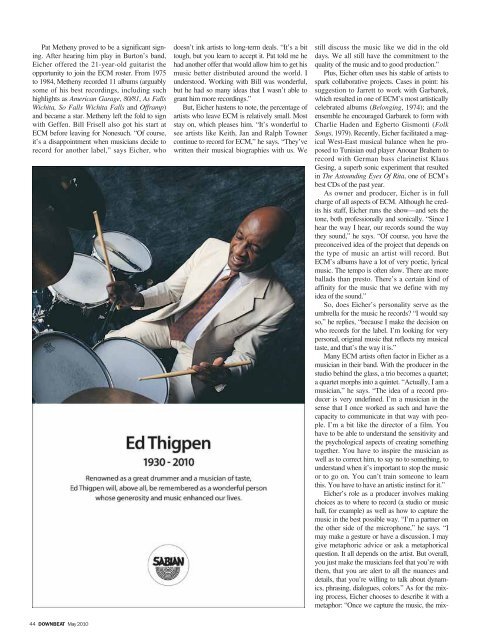Download - Downbeat
Download - Downbeat
Download - Downbeat
- No tags were found...
Create successful ePaper yourself
Turn your PDF publications into a flip-book with our unique Google optimized e-Paper software.
Pat Metheny proved to be a significant signing.After hearing him play in Burton’s band,Eicher offered the 21-year-old guitarist theopportunity to join the ECM roster. From 1975to 1984, Metheny recorded 11 albums (arguablysome of his best recordings, including suchhighlights as American Garage, 80/81, As FallsWichita, So Falls Wichita Falls and Offramp)and became a star. Metheny left the fold to signwith Geffen. Bill Frisell also got his start atECM before leaving for Nonesuch. “Of course,it’s a disappointment when musicians decide torecord for another label,” says Eicher, whodoesn’t ink artists to long-term deals. “It’s a bittough, but you learn to accept it. Pat told me hehad another offer that would allow him to get hismusic better distributed around the world. Iunderstood. Working with Bill was wonderful,but he had so many ideas that I wasn’t able togrant him more recordings.”But, Eicher hastens to note, the percentage ofartists who leave ECM is relatively small. Moststay on, which pleases him. “It’s wonderful tosee artists like Keith, Jan and Ralph Townercontinue to record for ECM,” he says. “They’vewritten their musical biographies with us. Westill discuss the music like we did in the olddays. We all still have the commitment to thequality of the music and to good production.”Plus, Eicher often uses his stable of artists tospark collaborative projects. Cases in point: hissuggestion to Jarrett to work with Garbarek,which resulted in one of ECM’s most artisticallycelebrated albums (Belonging, 1974); and theensemble he encouraged Garbarek to form withCharlie Haden and Egberto Gismonti (FolkSongs, 1979). Recently, Eicher facilitated a magicalWest-East musical balance when he proposedto Tunisian oud player Anouar Brahem torecord with German bass clarinetist KlausGesing, a superb sonic experiment that resultedin The Astounding Eyes Of Rita, one of ECM’sbest CDs of the past year.As owner and producer, Eicher is in fullcharge of all aspects of ECM. Although he creditshis staff, Eicher runs the show—and sets thetone, both professionally and sonically. “Since Ihear the way I hear, our records sound the waythey sound,” he says. “Of course, you have thepreconceived idea of the project that depends onthe type of music an artist will record. ButECM’s albums have a lot of very poetic, lyricalmusic. The tempo is often slow. There are moreballads than presto. There’s a certain kind ofaffinity for the music that we define with myidea of the sound.”So, does Eicher’s personality serve as theumbrella for the music he records? “I would sayso,” he replies, “because I make the decision onwho records for the label. I’m looking for verypersonal, original music that reflects my musicaltaste, and that’s the way it is.”Many ECM artists often factor in Eicher as amusician in their band. With the producer in thestudio behind the glass, a trio becomes a quartet;a quartet morphs into a quintet. “Actually, I am amusician,” he says. “The idea of a record produceris very undefined. I’m a musician in thesense that I once worked as such and have thecapacity to communicate in that way with people.I’m a bit like the director of a film. Youhave to be able to understand the sensitivity andthe psychological aspects of creating somethingtogether. You have to inspire the musician aswell as to correct him, to say no to something, tounderstand when it’s important to stop the musicor to go on. You can’t train someone to learnthis. You have to have an artistic instinct for it.”Eicher’s role as a producer involves makingchoices as to where to record (a studio or musichall, for example) as well as how to capture themusic in the best possible way. “I’m a partner onthe other side of the microphone,” he says. “Imay make a gesture or have a discussion. I maygive metaphoric advice or ask a metaphoricalquestion. It all depends on the artist. But overall,you just make the musicians feel that you’re withthem, that you are alert to all the nuances anddetails, that you’re willing to talk about dynamics,phrasing, dialogues, colors.” As for the mixingprocess, Eicher chooses to describe it with ametaphor: “Once we capture the music, the mix-44 DOWNBEAT May 2010
















